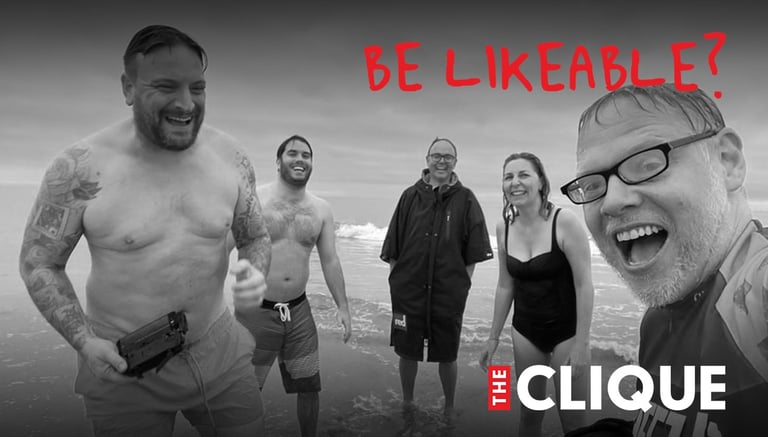Be More Likeable


// Why be likeable?
The key phrase in sales and marketing that gets banded around by every man and his dog is ‘Know, Like and Trust’ - of course someone needs to know you to buy (and that’s the job of marketing) and of course, they need to trust you in order to place that order but the bit in the middle was always a difficult one for me - being ‘liked’ is subjective and isn’t as easy to quantify.
I guarantee that my circle of friends is completely different to yours (because they're my friends, not yours) and vice versa. I bet that some of your friends would probably hate me and what I stand for (and again, vice versa) but that’s what every business looks like - some people will love you and your business and others will have this other idea about you.
So how can we influence the ‘like’ part of the “Know, Like, Trust” equation?
How can we make sure that more people like us and therefore, trust us more to buy more?
I put this down to the people within your brand which allow you to be at the forefront of your marketing - it’s your job (if you’re a one man band) and it’s your team’s job to deliver on the next four key points to boost your chances of being ‘liked’.
// Expectations.
Customer service before you sign a client should be your focus.
Read that again.
Yep, I said that customer service before you sign a client should be your focus - but how? It’s fairly easy when you take a step back and look at where you need to excel - you need to be delivering both messaging and content which reduces the fears of any purchase before the purchase and showing examples of where you have consistently met or exceeded your clients expectations will go some way to showing your prospective customers that you can be trusted - your goal is to move people from the ‘know’ through the ‘like’ and into the ‘trust’ area.
You can also achieve this with consistent branding, marketing materials and a clear and easy to use way of describing your products - if you’re product or service lineup can only be understood by your own sales teams and not by your customers then you’re missing out on a key brick in the customer service wall.
Using clear, defined and standard marketing materials show off a professional and cohesive image for your brand - if everything you post, talk about and create has a clear sense of identity then this sets a clear expectation with your clients that you know what you’re doing.
If you’re the only ones who know how your service (or product) works then you are creating a bottleneck in your business - you’re not opening up the funnel to allow your customers to make that choice for themselves.
All of this builds trust and sets a clear expectation with your customers and your clients alike.
Actions to take - review your marketing; does it showcase your clear marketing brand identity? Does it make it easy for your clients to make a decision? Does it showcase your clear customer focus and customer service principles? Will it move people from ‘know’ to ‘trust’?
// Memories.
You know the one thing I like about Facebook (and it literally is the only thing I like on the platform) is the resurfacing of memories - regurgitating posts and showing them off. Just this weekend, I had a post resurface of my son from 9 years ago - I posted a picture of him and the beautiful thing was? I’d forgotten about that memory.
Now, how can we take that and make it work for our clients?
My wife runs a wax melt company - it’s a small business and very boutique but one thing that she will always do for her clients is share their stories. By this, I mean that she will relentlessly share the Instagram stories of her clients which show off her brand - this does two things in my mind.
It connects her account (which has over 16k followers) with her clients accounts (which are personal and often have only a few hundred followers).
It brings her closer to her followers by creating a memory. They were shared by a ‘big’ account.
She also handwrites a note in every package that she sends out - by doing just these simple things, she is creating a memorable experience for her customers and it leaves a lasting impression.
All of these interactions enhance the customer experience and build on the expectations that we’ve set earlier on - we’re building up this image of personalised interactions, adding in surprise and little delight moments.
You can do this immediately using a ‘video’ first approach - every time someone connects with your brand, every time someone follows your or connects with you - send them a video to say hi?
Mark Masters does this with his newsletter - he sends an introduction video which is personalised (no canned videos in his funnel) which is personalised to the subscriber - I think this is an absolutely brilliant way to welcome people to his little slice of the internet and I still remember my first video - it’s created that memory.
Actions to take - Leverage nostalgia and personal connections to elevate client experiences, such as sharing client stories on social media to forge lasting memories. Simple gestures like handwritten notes in packages create a personalized touch that exceeds expectations and fosters brand loyalty.
// Stories
I was recently on a small little podcast with Mark Masters and Sarah Townsend to talk about the You Are the Media Creator day which is coming up on 25th April and whilst I love doing podcasts, it was really nice to hear some feedback from Sarah after we’d finished recording it - she said to me that every time I make a point, I tell a story to relate to that point and she wishes she’d done that in our chat.
I have never thought about story telling as a conscious effort - it’s just something that I do. I tether my experience and my knowledge in stories as it always gives us a relatable starting point. Every story has a relatable element which is why we start reading from a young age - even when we can’t relate, we engross ourselves in the story telling element and lose ourselves.
We want people to do that with our brands and our businesses - if you’re a business which is growing and you’re expanding your team in a way which is unconventional - tell people about it. If you’re a business which is about to move premises - take people on that journey.
People want to hear stories all day - that’s why they gossip in the office, that’s why they scroll through social media. But you know what people don’t want to hear about? Your products or service.
The power of storytelling is that there is an extremely low entry point because the story being told is on a human to human level - you’re tapping into your own frustrations, your own values and aspirations and sharing them (on an emotional level) with your audience. People resonate with that way more than a picture of your product.
If I had to chose between two brands - one which showed off the technical features and the capabilities of their products or one which showed off their people, what they were up to and how they are trying to succeed - I would chose the latter every day yet when it comes to marketing our businesses people always seem to defer to the former as it’s what everyone else does.
Actions to take - Integrate storytelling into your content by prioritizing authentic behind-the-scenes content that highlights your team, journey, and values, setting your brand apart from competitors and fostering deeper connections with your audience.
// Relationships
The biggest and single most important aspect of being liked is obviously the relationships that you build with your clients but it’s also important to show off the relationships you have with your staff too (if you have them) and your network.
The importance of building genuine relationships with customers based on trust, transparency, and empathy can never be understated - it’s the fundamental factor in moving across the ‘like’ scale towards that all important ‘trust’ factor.
As I mentioned with my wife’s business - whilst she has a small business, she interacts with her customers way beyond social media interactions and she is close to saying that she has a small community around her brand - all of this is built on the vulnerability and transparency that she offers on her social media presence.
The important thing about sharing your relationships with your staff and your clients is that it sets a tone for how people will be dealt with - if everything you do is clear and transparent then again, you’re clients will probably have the sense that they will all have the same treatment.
Of course, I’m talking about the initial stages of building your business or brand in the eyes of the consumer but the longer term relationship and brand advocacy also plays a huge part - the long term supporters of your brand will do a huge job as they will support your content, support your messaging and reinforce the key aspects of your brand.
Actions to take - Building genuine relationships with clients and staff fosters trust and transparency, setting a tone for fair treatment and long-term brand advocacy, especially when showcased through transparent social media presence.


